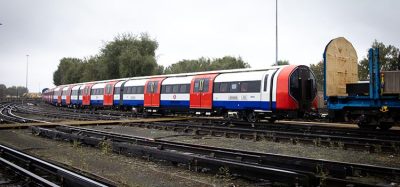Tilting trains – another idea for speed
Posted: 27 September 2008 | | No comments yet
Between 2003 and 2005, the world high and very-high-speed market represented an average of €2.4 billion1, just over half of which was accounted for by high-speed…


In the next ten years, the market is expected to grow significantly, in particular in eastern Europe, where demand for high-speed equipment is expected to grow by 5.1% per year. Russia, for example, is planning to build no fewer than 18 high-speed lines in the next few years.
Alstom, the undisputed market leader in high and very-high-speed, also leads the market for tilting trains. Since it acquired Fiat Ferroviaria, in the year 2000, Alstom has been at the cutting edge of tilting technology – a technique that enables trains to operate at greater speeds than conventional trains on existing infrastructure, and in particular on winding networks. The tilting technique makes it possible to respond to three major issues facing railway transport operators: comfort, performance and interoperability.
High-speed – a market that remains principally European
The high-speed trains sector covers mainly electric trains (EMU2), be they conventional or tilting. Their speeds range from 200 to 250km/h. With a world market share in electric high-speed trains of 50% and a European market share of 77%, Alstom is the leader in this sector with more than 430 high-speed trains – most of them have been manufactured in its factories of Savigliano and Sesto San Giovanni in Italy.
Alstom’s leadership is indisputable in the sector for tilting electric trains, with a world market share of 95% and in Europe. With over 80% of the market concentrated in Europe, the market for tilting trains is principally located in the United Kingdom (17.2%), in Germany (Italy (17.1%), in Switzerland (14%) and in Italy (13%). It is currently witnessing strong growth in Italy, Switzerland and Germany, with the expansion of existing fleets. New opportunities are also emerging in countries such as Sweden, Hungary, the Slovak Republic, Czech Republic, Taiwan and Korea.
Among tilting trains, Alstom’s Pendolino has been a genuine success story since its launch in the early 80s, and is now operating on over 200 million kilometres covered in commercial service.
The Pendolino operates in 10 countries: Italy, Germany, the Czech Republic, Switzerland, Slovenia, the United Kingdom, Portugal, Spain, Finland and Austria. Russia will be added to the list from 2010, with the opening of the high-speed line between Saint Petersburg and Helsinki.
Tilting – a technique adapted to existing infrastructure and winding networks
Tilting trains are particularly well adapted to the needs of operators wishing to quickly put into service high-speed trains, without major investment or disturbance to the environment, as would be required if specific new lines were constructed.
Active tilting technology, such as the one developed by Alstom for the Pendolino, makes it possible to limit the unpleasant effects of centrifugal acceleration on the passengers when operating at high-speeds on winding lines. When the trains enter into a curve, passengers are subject to centrifugal forces which push them towards the outside of the curve. This force increases with the increase of speed. The principle aim is to tilt the vehicles towards the interior of the curve when entering, which will partially compensate the centrifugal force felt by the passenger and giving the possibility to run in the curves at higher speeds with a greater level of comfort. In comparison to the conventional trains, to improve furthermore the passenger comfort, Alstom has developed and has installed a pneumatic lateral active suspension in the Pendolino.
On traditional tracks, the tilting technique enables trains to operate at a speed 20% to 30% greater than conventional trains – thanks to ‘lean over’ of up to eight degrees. Journey times can therefore be reduced by between 10% and 20%, depending on operating conditions.
The heart of the system is the Tiltronix control unit. The control law is based on signals taken from sensors (gyroscopes an accelerometers) installed on the bogies. The signal filtering and the algorithms (to detect the curves and to tilt the train) have been defined to reduce the ‘jerk’ on the passengers in transients when the train goes in and out of curves and to avoid oscillations due to track irregularities.
The requested tilt angle and the tilting speed is calculated on the first vehicle of the train and transferred to all the others according to their position in the train and the actual train speed.
The traditional Tiltronix defines the tilting angles of the bodyshell in curves from the sensor signals – it reacts to the sensor signals.
Now available is a new ‘anticipative’ Tiltronix. In the control unit, there is a database which highlights the line parameters and the localisation of the train – the lines are made comparing the data in the database and the data derived from the sensor signals. In synthesis, the control unit knows which is the line ahead of the train and in this way it can tilt the vehicles with less delay and it is not influenced by the track irregularities.
Performance, interoperability and comfort: the challenges for tilting trains
Today, both high-speed trains and tilting trains must overcome several challenges including enhanced performance, respect for interoperability standards and an increasingly greater level of comfort.
The train operators require improved performances such as reduced journey times, more passenger capacity and modularity and less LCC (Life Cycle Cost).
The Tilting train is the answer to the needs of many train operators who want to achieve significant reductions in journey times on conventional lines, while limiting their investment to a modification of the existing infrastructure, without the creation of a new line. Increased passenger capacity means to reduce to a minimum the space of the train that cannot be equipped with seats and modularity means to have the possibility, during the life-span of the train, to adapt the interior lay outs to new passenger expectations.
To optimise LCC, it is necessary to have more reliable trains but to also improve the train maintainability.
Interoperability currently represents a major issue for railway operators, in particular in Europe, where the rail networks are developing and expanding. To enable the operators to operate cross-border services, the trains have to operate under different voltage systems – to have the common European signalling system – and to be compliant with the TSI standards but also to be suitable to be operated under different climatic conditions.
Passenger comfort of course includes the dynamic running comfort and also the interior design and the ergonomic outlook. The climatic and acoustical comfort is also taking into consideration as well as the passenger information and entertainment systems and the services offered during the journey, for example the bar/cafeteria/restaurant).
‘New Pendolino’ – the fourth generation of ALSTOM tilting trains
The ‘New Pendolino’ is an evolution and a break-through in the Pendolino family, because it has been developed by considering the actual expectations of the operators in its performance, in its interoperability and in its passenger comfort.
The ‘New Pendolino’ is a 250km/h tilting train which has the possibility to be equipped with the ‘anticipative’ Tiltronix and to incorporate new technological achievements for the traction equipment: the power of the traction unit has been increased by 37% thanks to the IGBT water cooled traction converter.
The train is streamlined to increase its aerodynamic efficiency (energy saving) and the cross wind sensitivity.
The interior layouts offer modular solutions and more space for the passenger compartments, thanks to the tilting pantographs.
For the safety of the passengers, the ‘New Pendolino’ has an energy absorption system compliant with the TSI crashworthiness requirement.
LCC has been optimised due to the improved reliability of the equipments and the improved maintainability. There is the possibility to have easier maintenance of the train thanks to the ‘e-train’ system, which transmits information relating to breakdowns directly to the maintenance depot, making it possible to reduce the length of the maintenance cycle and therefore limit costs.
The ‘New Pendolino’ is an interoperable train that can be operated under three voltages (3 KV dc, 25 KV 50 Hz and 15 KV 16 2/3 Hz), all compliant with TSI and it is equipped with a signalling system compatible with level-2 ERTMS.
The Pendolino family has always enabled the operators to exploit cross-border services: the Pendolino Cisalpino (ETR 470), for example, has been operating since 2002 between Germany, Switzerland and Italy and the Pendolinos delivered in 2006 to the Czech Republic (CDT 680) are capable of operating on three different national networks (Czech Republic, Germany and Austria).
Thanks to the ‘winterization’, the Pendolino family can also operate in extreme climatic conditions, such as in the Nordic Countries (as the Finnish Pendolino) and in Russia (the Pendolino that will be operated in 2010 between Helsinki and St.Peterburg).
The interior design of the ‘New Pendolino’, developed by ‘Giugiaro Design’, places the accent on ergonomic aspects and the perceived comfort and it is based on rounded forms and refined lines.
Noise reduction has also been the subject of particular attention in the ‘New Pendolino’, so as to fulfill the new European standards. The train is streamlined to reduce aerodynamic noise and sound insulation has been increased to improve the passenger comfort.
Unique technologies and services are available on board such as:
- Touch screens
- Broadband WiFi connections via an intranet server
- Loudspeakers
- GSM-R/GPRS connection systems
- GPS to view progress in real time and communicate via the train and the ground
- A video surveillance system
The ‘New Pendolino’ can have a bar/cafeteria or a restaurant car to enable the operators to personalise their offer to its passengers.
The 12 ‘New Pendolinos’ for Trenitalia that will run on conventional and new high-speed lines in Italy and the 14 ‘New Pendolinos’ for Cisalapino that will link Italy, Switzerland and Germany, are part of this product platform.
References
1. UNIFE research, 2007
2. Electrical Multiple Unit
OUT NOW: The Definitive Guide to Rail’s Digital Future
The rail industry is undergoing a digital revolution, and you need to be ready. We have released our latest market report, “Track Insight: Digitalisation.”
This is not just another report; it’s your comprehensive guide to understanding and leveraging the profound technological shifts reshaping our industry. We move beyond the buzzwords to show you the tangible realities of AI, IoT, and advanced data analytics in rail.
Discover how to:
- Optimise operations and maintenance with real-time insights.
- Enhance passenger services through seamless, high-speed connectivity.
- Leverage technologies like LEO satellites to improve safety and efficiency.
Featuring expert analysis from leaders at Nomad Digital, Lucchini RS, Bentley Systems and more, this is a must-read for any rail professional.







